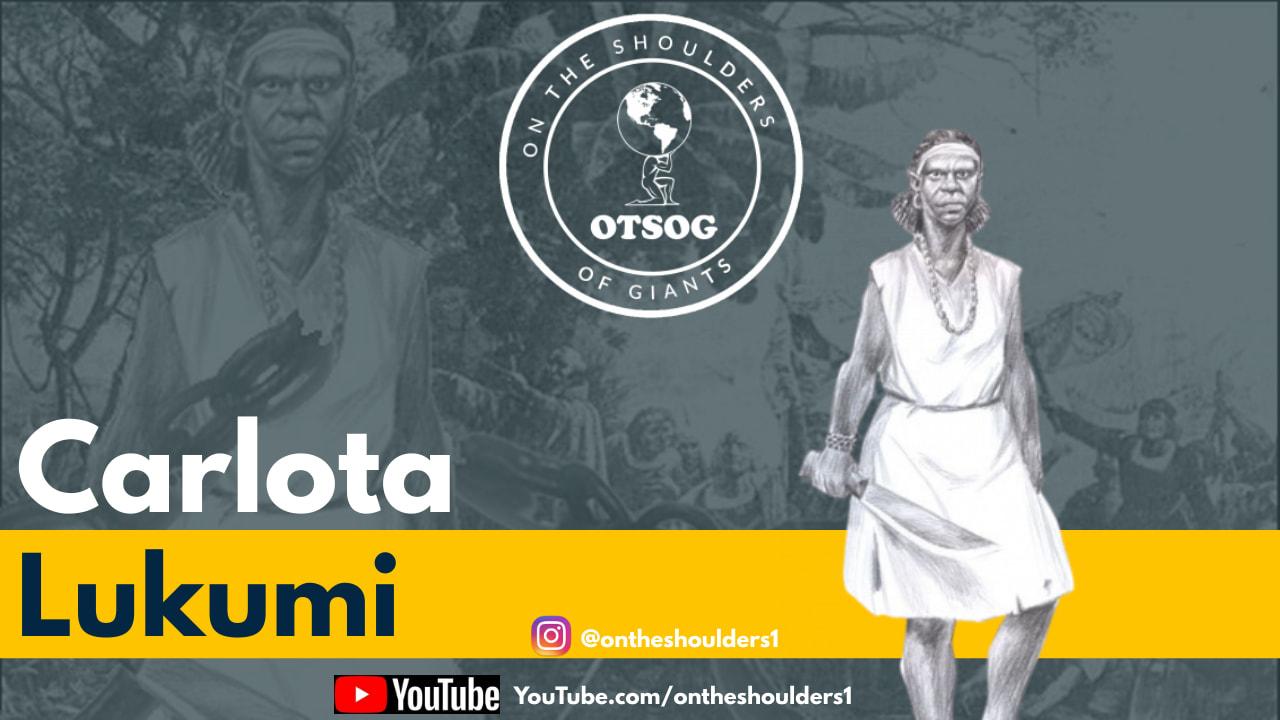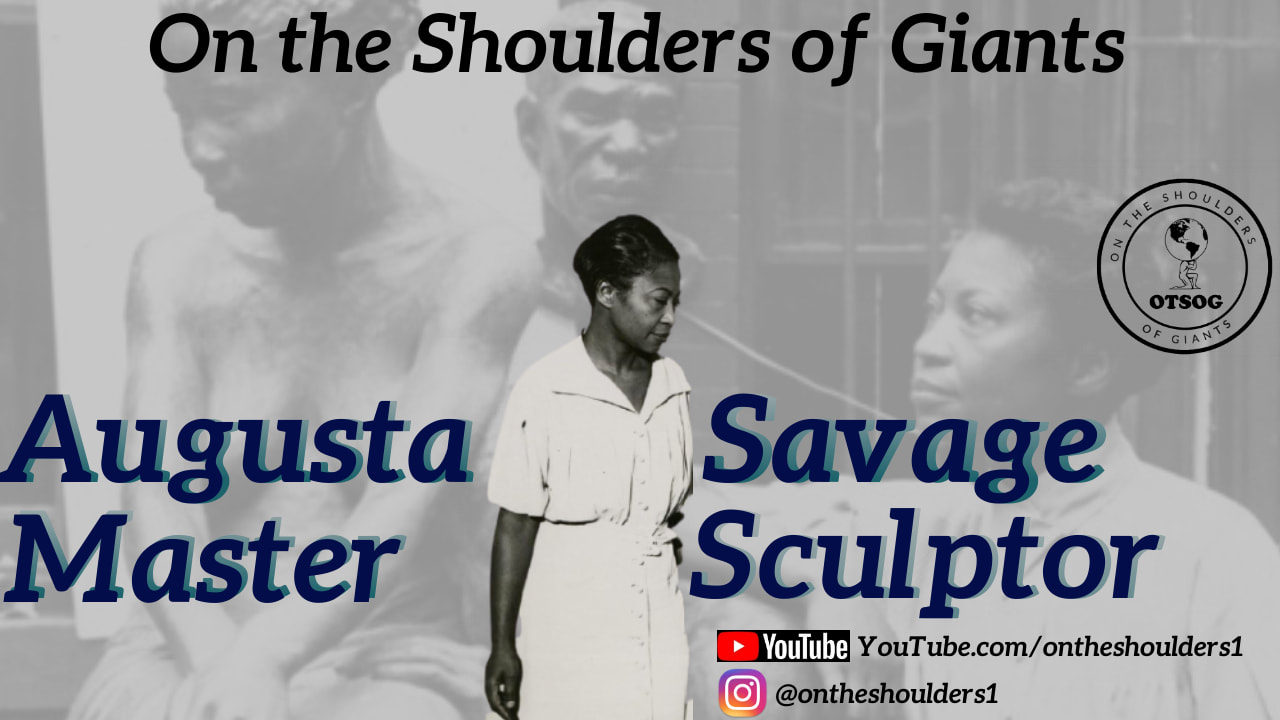|
Click the link to join the OTSOG family and get a free copy of On the Shoulders of Giants Vol: 1 North America https://lp.constantcontactpages.com/s...
Support us on Patreon: https://www.patreon.com/OTSOG Cashapp: $joeward84 Follow us on Instagram and Twitter @ontheshoulders1 Visit www.ontheshoulders1.com to download our African history curriculum app Like us on Facebook: On the Shoulders of Giants Connect on LinkedIn: Joseph Ward Click the link to get your copies of On the Shoulders of Giants book series http://ontheshoulders1.com/store/
0 Comments
In the early 1800s, a young girl named Carlota was kidnaped from her Yoruba village in Nigeria and transported to Mantanzas, Cuba. While living in Cuba, she was sold to a sugarcane plantation in Triumvarato where the conditions were poor and inhumane. Carlota was strong-willed and vigilant, she refused to let her conditions break her. In 1843 Carlota met a fellow slave girl named Fermina who planned an uprising. Carlota was willing and able to help Fermina raid the plantation to gain their freedom. Unfortunately, the plantation owners learned of Fermina’s plans, she was beaten and locked in jail. Carlota was not deterred by Fermia’s incarceration; she used the talking drum to communicate to the others about her plans. The slaves would often use their drums as a safe way to communicate with each other. Using the drums Carlota organized a raid on the plantation which helped to free Fermina and others from jail. November 5th, 1843, is said to be the date the slaves led by Carlota launched their yearlong raid against the whites and plantation owners. The slaves used guerilla tactics to attack the whites which helped them to gain victories for a short while. Ultimately, Carlota and her comrades were captured and executed by the Spanish plantation owners. She would inspire future uprisings against slavery and oppression. Her ideas and passion did not die with her; they were continued by those who shared her vision. Even though Carlota was not successful in the end, she represents the spirit of freedom, the spirit of liberty. Humans were born to be free and she was not going to lie down and accept her conditions. She possessed brains, tact, skill, courage, leadership, and a love for her people. Ms. Carlota Lukumi, we proudly stand on your shoulders. J.A. Ward. Click here to support the On the Shoulders of Giants book series!! Carlota Lukumi: https://badassladiesofhistory.wordpress.com/2014/07/04/carlota-lukumi/ http://www.afrocubaweb.com/carlota.htm On February 29, 1892, Augusta Christine Fells was born in Green Cove Springs, Florida, to parents Edward Fells and Cronella Murphy. Augusta was the seventh of fourteen children and developed a love for art at an early age. Her father was a Methodist Preacher who believed sculpting was a sin because it was the creation of graven images. As a result of his beliefs, Augusta stated that she received a whopping four or five times a week. Augusta and her family moved to West Palm Beach, Florida where she attended a new high school. Her attending this new school was pivotal because the principal helped her to develop as an artist. As a senior in high school, the principal paid her a dollar a day to teach classes on molding clay. Augusta turned sixteen years old in 1907, this was also the year she married her first husband Mr. John T. Moore, and the couple produced a baby girl Irene Connie Moore. Unfortunately, years later Mr. Moore died which made Augusta a teenage widow. In 1915, Augusta married a carpenter named James Savage who she remained married to until their divorce in the early to mid-1920s. Augusta did not allow her personal issues to distract her from doing what she loved, which was sculpting masterful pieces of art from clay. Her continued sculpting led her to earn a display booth at the Palm Beach County Fair where her sculpture won a twenty-five dollar prize for the most original piece. Augusta eventually won her father’s support after she sculpted figures of the Virgin Mary and other religious figures. With new confidence, Augusta moved to Jacksonville, FL with hopes of sculpting busts of prominent black figures. She failed miserably and needed to create another plan of action for herself. Augusta began attending Florida Agricultura & Mechanical College for Negroes, which is now The Florida Agricultural & Mechanical University, a place where your dreams can come true if you take the right steps and believe. Augusta won first prize in a county fair in Tallahassee, FL for her sculptures, the commissioner of the county fair recommended her as a student who should study art in New York City at The Cooper Union, a private art college. Augusta thrived at Cooper Union, she thrived so much that she was awarded a scholarship just to pay her bills and live. At Cooper Union, Augusta had the privilege of studying under the well-known sculptor George Brewster, she also completed a four-year program in three years. Her name was starting to spread around New York City as a talented sculptor, it spread so much that Augusta was now sculpting busts for W.E.B. DuBois and the Honorable Marcus Garvey. 1923, was the year that Augusta married her third husband Mr. Robert L. Poston, a member of Marcus Garvey’s Universal Negro Improvement Association, unfortunately, Mr. Poston died of pneumonia aboard a ship in 1924. Later in 1924, Augusta applied for a scholarship to attend a special summer art program in France, she was very qualified and the committee wanted her to attend until they learn she was a black woman. After being denied because of her race, Augusta used the local newspapers to get the story out about her being discriminated against, but it didn’t sway the committee of the art camp to change their minds. Augusta would face more tragedy, her father became paralyzed, then her family’s house was destroyed by a hurricane, she was forced to move her family into her cramped New York apartment. Augusta’s luck seemed to start to change when she was offered a scholarship to attend the Royal Academy of Fine Arts in Rome, Italy, but was unable to raise enough funds to travel to Italy and live. In 1928, her sculpture Head of a Negro won the Otto Khan prize at the Harmon Foundation exhibition of 1928. Augusta understood her platform and understood that she needed to use her voice as well as her hands to speak up about injustices. She was very outspoken about the white artist and critics fetishizing black art through a “negro primitive” lens. She also believed that the white art world lacked respect and an honest view of black art. Between 1928 and 1930, a picture of Augusta’s sculpture Gamin made the cover of Opportunity Magazine, members of the Julius Rosenwald Fund saw the magazine cover then gave Augusta a scholarship of $1,800 to study in Paris, France. Augusta’s dream of studying with the greatest sculptures and artist in the world actually came true. While in Paris she worked and studied with Felix Benneteau; she would later write that the experience with Benneteau was no ideal and she eventually began teaching herself more about sculpting. Augusta went on to attend one of the leading art schools in Paris the Académie de la Grande Chaumière, where she excelled, winning multiple awards and traveling Europe displaying her art. In 1931, Augusta made her return to the U.S. during the Great Depression, which meant it was hard for her to find work as a sculptor. She began working as a teacher and was able to sculpt busts for Frederick Douglas, W.C. Handy, and James Weldon Johnson. She became the first black woman to be elected to the National Association of Women Painters and Sculptors. She then opened her own art studio in Harlem, NY, the Savage Art Studio, which was a place that helped to nurture future young black artists such as Gwendolyn Knight, Kenneth B. Clark, Norman Lewin, and Jacob Lawrence. The Savage Art Studio eventually became the Harlem Community Art center that served over one thousand and five-hundred people in the community. With a commission from the Board of Design of the New York World’s Fair, she sculpted a sixteen-foot sculpture titled “Lift Every Voice And Sing” also known as “The Harp”, which was inspired by the Negro National Anthem. Augusta opened two art galleries but was unable to sustain them, such a great artist was encountering tragic financial troubles. 1940 was the last time Augusta showed her art to the world. She later moved to upstate New York and worked as an art teacher for around 20 years before dying in New York City in 1962. Augusta Savage was gone but not forgotten. The Augusta Savage Institute of Visual Arts was created, as well as the Augusta Savage Cultural Arts Center. In 2009, author Alan Schroder wrote the book In Her Hands: The Story of Sculptor Augusta Savage. She was gifted with her hands, she was a powerful visionary, and tactical with her voice, all of which made a potent combination of a woman who endured much tragedy but always understood that it was up to her to create her world. To Ms. Augusta Savage, we proudly stand on your shoulders. J.A. Ward Click here to support the On the Shoulders of Giants book series. References: https://americanart.si.edu/artist/augusta-savage-4269 https://en.wikipedia.org/wiki/Augusta_Savage https://dos.myflorida.com/cultural/programs/florida-artists-hall-of-fame/augusta-savage/ |
Details
Categories
All
Click Here to join our mailing list
|
Contact Us: |
Connect With Us |
Site powered by PIT Web Design



 RSS Feed
RSS Feed



